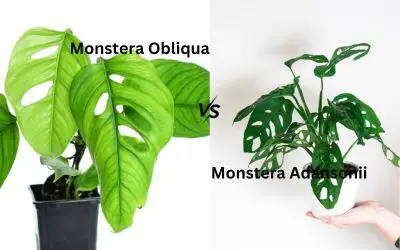Have you ever taken a closer look at Monstera Obliqua and Monstera Adansonii? Do you get confused and wonder which plant is which?
These plant species share a close similarity and cause a lot of confusion.
If you’re interested in one of these species, you must be careful when purchasing. Remember, you don’t want that disappointing look on your face when you take the wrong plant home.
To help you make the right choice, we have covered Monstera Obliqua vs Adansonii in this article. We’ve also listed the common differences and similarities. So, read on!
How Can You Tell Monstera Obliqua and Monstera Adansonii Apart?
You can tell the two species apart by looking at their leaf shape and fenestrations. Monstera Obliqua has more elongated and narrow leaves with irregular fenestrations.
Conversely, Monstera Adansonii has more round leaves with round fenestrations. And the holes may be larger in diameter than Monstera Obliqua. What is Monstera Obliqua?
Monstera Obliqua vs Adansonii
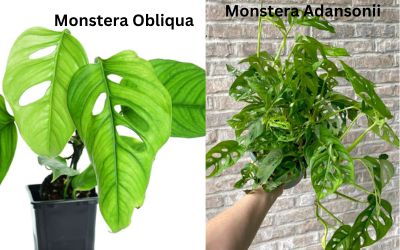
Have you ever taken a closer look at Monstera Obliqua and Monstera Adansonii? Do you get confused and wonder which plant is which? These plant species share a close similarity and cause a lot of confusion.
If you’re interested in one of these species, you must be careful when purchasing. Remember, you don’t want that disappointing look on your face when you take the wrong plant home.
To help you make the right choice, we have covered Monstera Obliqua vs Adansonii in this article. We’ve also listed the common differences and similarities. So, read on!
How Can You Tell Monstera Obliqua and Monstera Adansonii apart?
You can tell the two species apart by looking at their leaf shape and fenestrations. Monstera Obliqua has more elongated and narrow leaves with irregular fenestrations.
Conversely, Monstera Adansonii has more round leaves with round fenestrations. And the holes may be larger in diameter than Monstera Obliqua.
What is Monstera Obliqua?
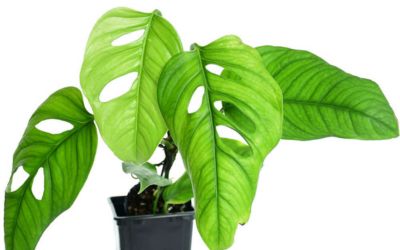
Monstera Obliqua is a plant species that belongs to the Araceae family. It’s a tropical vine originating from Central and South America. This Monstera genus is also known as the Swiss Cheese plant.
Its distinctive holes and splits make it unique, hence the “ Swiss Cheese plant.” At some point, it’s always mistaken for a Monstera deliciosa.
One incomparable nature of the rare Monstera Obliqua is its slow growth habit making it a rare plant species.
So, if you get hold of one, it’s best to practice the best care routine to enjoy the plant’s aesthetics.
This species enjoys a good amount of bright indirect sunlight. And a well-draining potting mix, among many other care routines.
You can also propagate Monstera Obliqua and enjoy the benefits of having more of its species.
What is Monstera Adansonii?
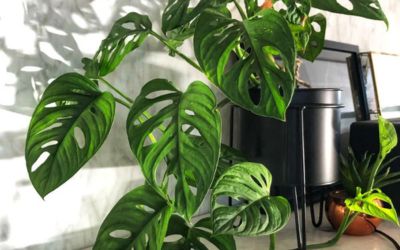
Monstera Adansonii, or Adanson’s monstera or “five holes” plant, is also a Monstera plant species of the Araceae family. It’s a tropical plant species native to Central and South America.
Moreover, it has spread to the West Indies on several islands. That is Tobago, Trinidad, Guadeloupe, St Vincent, St Lucia, St Kitts, Dominica, and Grenada.
Monstera Adansonii has small heart-shaped leaves with distinctive perforations and splits.
It also has a long and slender stem allowing it to climb on wild trees or moss poles when grown as a houseplant.
Fortunately, the Monstera Adansonii is an easy-to-care-for houseplant. It prefers bright indirect light and moist but well-draining soil.
Additionally, ensure that the plant receives the right humidity and temperatures.
Like the rest of the Monstera species, Adansonii is also an air-purifying plant. Meaning it can help improve indoor air quality.
Differences Between Monstera Obliqua and Monstera Adansonii
Several factors can help you distinguish the rare Monstera Obliqua and Adansonii. These factors include:
1. Leaf thickness
The first comparison between the two Monstera genus is their leaf thickness. Monstera Obliqua has thinner leaves, almost the thickness of the paper. This makes them very delicate.
So, avoid any lengthy hand contact with this Monstera plant to keep your plants from damage.
Adansonii’s leaf thickness is quite the opposite of Monstera Obliqua. This Monstera plant has thicker leaves.
It is leathery, rough in texture, and therefore less delicate than the Obliqua.
Now that you know the difference in the leaf texture, you can choose the plant that suits you best. If you are clumsy, getting a Monstera Obliqua will require you to be careful.
2. Shape and size of fenestrations
The second comparison between the two species is the shape and size of fenestrations, also called holes.
Monstera Obliqua has narrower and elongated holes, whereas Adansonii has more rounded ones.
The Obliqua holes allow light to penetrate the plant’s canopy, enabling photosynthesis.
When younger, the Adansonii’s leaves have more splits than holes. As they grow, they develop holes but never grow larger. The holes are more elongated than round.
Monstera Obliqua’s large holes will make you think they barely have leaves. And since the leaves are not so much left, they are delicate.
3. Edges of the leaves
The third comparison is the leaf edges of both the Monstera plant species. This may not be a common difference, but you can still use it to separate the Monstera Obliqua from Adansonii.
When you look closer, you’ll notice Monstera Obliqua leaves with slightly wavy edges. Adansonii, on the other hand, has straight leaf edges.
4. Growth rate
Another distinguishing factor between the two Monstera plants is their growth rate.
Monstera Obliqua has the slowest growth rate of all the Monstera plant species. The pattern is the same whether grown as a house plant or in its natural habitat.
I am not discouraging you from getting this plant, but I am setting you up for what’s to come. Some patience will do you justice for you to enjoy this houseplant.
Adansonii, on the other hand, is a fast-paced plant in terms of growth rate. You’ll be shocked to see this plant blooming after just a month of planting.
So if you are the impatient type, this is the best choice.
However, you must still provide these indoor plants with the right care routines to enjoy their aesthetics.
5. Runner or stolons
Another separating factor between the two species is runners or stolons. First off, you may be wondering what stolons are, right?
Stolons or runners are stems growing on or under the soil surface.
They form adventitious roots at the nodes and produce new plants from bud tips. A good example of a plant that produces stolons is the strawberry plant.
On that note, Monstera Obliqua develops stolons, unlike Adansonii, which doesn’t. A tip to take home, non-stolon plants develop stolon when stressed.
So, if you care for your indoor plants, always watch them.
6. Size of leaves
The easiest way to separate the two Monstera species is by looking at their leaf sizes. Monstera Obliqua has somewhat smaller leaves.
When mature, the leaves measure 5-10 cm (2- inches) in length and 3-5 cm (1-2 inches) in width.
On the contrary, Adansonii has larger leaves. When mature, the leaves grow to about 10-25 cm(4-10 inches) and 8-15 cm (3-6 inches) in length and width, respectively.
However, the leaf size varies depending on care routines, plant age, growth environment, and plant genetics.
Again, it may be a little tricky to separate the plants when young. But as they mature, the comparison becomes clear.
7. Inflorescence
The next difference between these species is in their inflorescence. Both produce a characteristic inflorescence called a spadix.
These spadixes have a surrounding called spathe which can be very showy and attractive.
The spathe in Monstera Obliqua is green, whereas in Adansonii, it’s white or cream-colored.
8. Price
The last comparison between the two species is their pricing in the market. Monstera Obliqua tends to be expensive. This is because of its rarity and slow growth.
If you check in online stores or nurseries, an Obliqua will range between $100 to $250. I know this is expensive, but we all know that rare can be expensive and worth it!
Adansonii, on the other hand, is quite affordable. Due to its fast-growth nature, it’s easy to come across in online stores and nurseries.
The price range may fall between $15 and $30. Why not get yourself an affordable and fast-growing houseplant anyways? Moreover, it’s less delicate and will give you less headache.
Similarities Between Monstera Obliqua and Monstera Adansonii
1. Care needs
The first similarity in both Monstera is their care requirements. These care requirements include:
- Lighting
Both Monstera Obliqua and Adansonii thrive well in bright indirect sunlight. They will suffer sunburns if placed in bright natural light.
- Temperature and humidity requirements
Both species do well in high humidity levels of 60% to 80% and temperatures of 60 to 80 degrees Fahrenheit. This is the case when in their natural habitat.
So, you must imitate these natural requirements in your home to suffice their growth. You can get a humidifier or a pebble tray to improve humidity levels.
Misting the plants is also a plus in maintaining humidity levels.
- Fertilizer
Both species enjoy a good amount of fertilizer rich in nutrients. You must watch how you fertilize the plants and get the best fertilizers for your Monstera. Too much fertilizer may damage the plants.
- Watering
Both Monstera Obliqua and Adansonii enjoy constant watering but with some limits. Overwatering may cause root rot and result in damaging the entire plant.
2. Classification
The second similarity that the two species share is their classification. Both Monstera Obliqua and Adansonii belong to the same family Araceae.
They are also part of the Monstera genus and originate from the same zones.
Fortunately, the Monstera Adansonii is an easy-to-care-for houseplant. It prefers bright indirect light and moist but well-draining soil.
Additionally, ensure that the plant receives the right humidity and temperatures.
Like the rest of the Monstera species, Adansonii is also an air-purifying plant. Meaning it can help improve indoor quality.
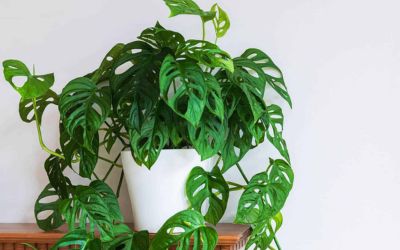
3. Root system
Monstera Obliqua and Adansonii have similar root structures. These species are both epiphytic.
Meaning they grow by attaching themselves to other plants when in the wild. The same pattern applies when grown as indoor plants.
For that matter, they’ll attach to moss poles or trellis for support.
In line with that, both plants produce aerial roots called adventitious roots. They use these roots to anchor to support structures.
Generally, the root system of both species adapts to their epiphytic nature.
And to keep these roots strong and healthy, you must not overwater the plants. You can also get moss poles to provide these epiphytic plants with the needed support.
4. Leaf color
Monstera Obliqua and Adansonii have similar leaf colors. You’ll notice a vibrant color in their leaves growing under bright, indirect light.
However, in low light conditions, the leaves may appear dark green.
Moreover, as the leaves age, the color may change. The leaves may develop brown or yellow spots or streaks.
This should not worry you as it is part of the growth process. You may notice slight differences in the leaf colors, but the general color stays green.
5. Repotting
Both species require repotting once every two years to suffice their growth. Unfortunately, leaving your plants in the same pots for years will do more damage than good.
The plants will outgrow their pots, and the roots will start intertwining or popping out of the soil surface. This process is what we call root bound.
Therefore, for the love of your plant’s comfort, please remember to change the pots.
6. Propagation
Both Monstera Obliqua and Adansonii can undergo propagation. The process is similar in both species.
Using a sterilized shear, cut off part of the stem at the nodes, ensuring at least one leaf.
Next, propagate the cutting in water or soil. Give the plant some time, and you’ll start seeing results.
One thing you need to do is to place the plant in the right position. Once the plant starts growing, you can transfer the plants to the soil. This is only applicable when you propagate in water.
7. Toxicity
Both Monstera Obliqua and Adansonii are toxic to humans and pets. This is because they contain crystal oxalate, which can harm you and your pets when in contact with the body.
This substance can cause fever, stomach upset, and vomiting when ingested.
The plant species remove sap, which can cause skin irritation and eye itchiness when in contact with the skin.
So, as an indoor plant parent, you need to be keen on handling the plants. You can also keep the plants out of pets’ and children’s reach.
See: Laniata vs adansonii
FAQs
Why is monstera obliqua so rare?
Monstera Obliqua is a rare plant because of its slow growth rate. These rare plants need special knowledge, and only experts can grow them. In addition, they are hard to propagate, which gives them more reasons for their rarity. Therefore, not just any house plant parent can propagate them.
How do I know if I have monstera obliqua?
You can identify a Monstera Obliqua by looking at the leaf fenestrations. Obliqua has more elongated and narrow holes. Similarly, you can also look at the slightly wavy leaf edges. Another key factor is the leaf thickness. This species’ leaves are very thin, almost the size of the paper, making them very delicate.
How do I make Monstera adansonii full?
Through early pruning. If your Adansonii is too leggy, you can propagate the plant in water or soil. Also, you can change your pot. All you need to do is get a bigger pot but not too large. This way, the roots will have room to spread out, giving your plants more chance to grow fuller.
Conclusion
We have concluded that the Monstera Adansonii is much more common. It’s also widely available compared to Obliqua.
We’ve also seen the differences in the leaf size, thickness, and fenestrations that may help you choose.
In addition to that, Adansonii is much easier to propagate than Obliqua. Thus, you can now make your selection with ease.
In general, both Monstera species are beautiful plants. But, if you are a beginner house plant parent, I would recommend Adansonii because of its ease of care.

